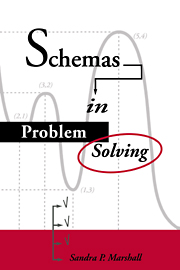10 - Schema-based assessment
Published online by Cambridge University Press: 22 October 2009
Summary
Schema-based assessment has the same focus as schema-based instruction but a different goal. The goal of the instruction is to facilitate the creation of schemas by students who experience the instruction. The goal of the assessment is to examine the extent to which learners have developed and can use the schemas that guided instruction. Schema-based assessment requires us to specify a priori the structure of the schemas to be assessed so that items evaluating those schemas can be constructed. In assessment, to a much greater extent than in instruction, the structure of the schema itself becomes a crucial factor because it influences the way that the test items are developed and interpreted.
Schema assessment presents some difficulties that do not arise in other types of assessment. A central one stems from the fact that schemas are highly individualized. Schemas are created and tailored by individuals to reflect their own experiences and understandings of the world. No two individuals will form identical schemas because no two individuals can experience the world identically, but both of them may have well-formed and useful schemas. The assessment question is: How can we obtain a true snapshot of schema development for these different individuals?.
Consider for a moment a case in which individualization is not a factor, namely, the acquisition of a particular fact by several individuals as a result of some instruction.
- Type
- Chapter
- Information
- Schemas in Problem Solving , pp. 267 - 289Publisher: Cambridge University PressPrint publication year: 1995



